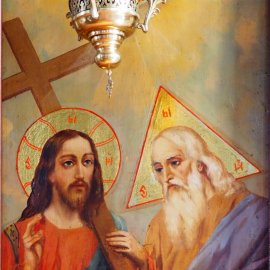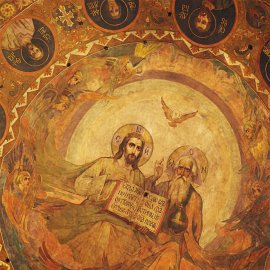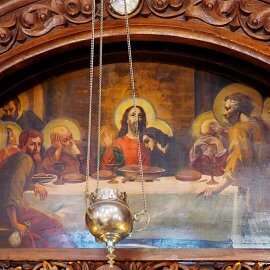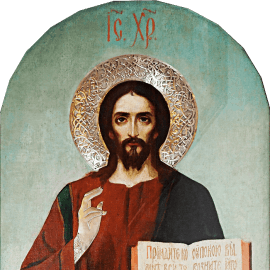Basic information
Born: 1 August 1873 (village of Demircha, present-day Romania)
Died: 27 July 1937 (Klisurski Monastery)
Art education
1896-1899 - State Art School;
1899-1900 - Art School at Kazan Academy of Arts;
1900-1905 - Imperial Academy of Arts, Saint Petersburg;
Painting in the churches of Sofia
- 1907–1912 – St. Alexander Nevsky Cathedral – one icon and murals;
- 1909 – Church of the Saints Cyril and Methodius – icons;
- 1911 – Church of Sts. Heptarithmoi – a crucifix on the Holy Throne;
- 1911–1912 – Church of St. Nicholas of Sofia the New – murals;
- 1918 – Church of St. George, 90 Patriarch Evtimiy Blvd. – icons;
- 1921 – Church of the Holy Spirit, Nadezhda district – icons;
- 1923–1926 – Church of St. Nicholas of Sofia the New – icons;
- 1926 – Church of the Sts. Heptarithmoi – murals in the dome;
- 1927 – Church of the Holy Trinity, Konstantin Velichkov Blvd. – icons;;
- 1927 – Church of St. Minas, Dragalevtsi monastery – icons;;
- Chapel of St. Catherine, the yard of the Church of St. Paraskeva, Orlandovtsi district – icons;
- Chruch of the Holy Transfiguration, Lozenets district – icons.;
State of research
Asen Vasiliev and Petar Karapetrov point out some churches where Gospodin Zhelyazkov worked1CDA, f.1680к, inv. 1, а.u. 1179, p. 4; CDA, f. 520к, inv. 1, а.u. 103, p. 3-4.. The fullest list of churches is given by protodeacon Stefan Markov who relies on information from G. Zhelyazkov’s daughter, Olga Gospodinova Bogdanova, and her husband Prof. Georgi Bogdanov2Markov 1988: 5.. Hristo Dimitrov provides information about the painting atelier St. Luke founded by Gospodin Zhelyazkov and Apostol Hristov3Dimitrov 1991: 75-79.. There are some publications examining his participation in the post-Liberation cultural life4Georgieva 2007: 84-92. and his icon painting work in specific churches5Ninov 2007: 40-44.. The most detailed examination of his church paintings made for the churches in the city of Sofia is made in the most recent studies6Yontcheva 2021: 259-282..
Biography
Gospodin Zhelyazkov Serbezov was born on 1 August 1873 in the village of Demircha, Romania. He became an orphan at the age of 11 and he left his birthplace to educate himself7Belkoveski 1947: 2.. He received his elementary education in the village of Bazarut (present-day village of Zhitnitsa), near Dobrich, and then he finished junior high school in the town of Dobrich and high school in Varna where Anton Mitov taught at the time. Most likely the initial creative impulses of the young artist were shaped at that time8Markov 1988: 4.. On 14 October 1896, the State Art School opened and admitted the first class of 48 students, Gospodin Zhelyazkov among them9CDA, f. 1680к, inv.1, а.u.1179, p. 2. . He studied in the class under Ivan Mrkvička. Among his fellow students were Asen Belkovski, Stefan Ivanov, Tseno Todorov, Aleksandar Bozhinov and Haralampi Tachev. As early as in the first year of the three-year course of study the young artist won the biggest monetary prize for his excellent marks10Markov 1988: 4.. In 1899, Gospodin Zhelyazkov completed the first batch of graduates of the Art School11Badzhov 1936: 7.. The same year the Holy Synod of the Bulgarian Orthodox Church announced a competition for gifted young artists to be encouraged by a scholarship to go to Russia and specialize in Orthodox icon-painting12Markov 1988: 4.. Zhelyazkov won the competition and left for Russia where he passed through the entire curriculum at the Art School in Kazan for one academic year. In 1900, he graduated from the Kazan Academy of Arts13CDA, f. 1680к, inv.1, а.u. 1179, л. 2. and the same year was admitted as a full-time student to the Imperial Academy of Arts in Saint Petersburg14CDA, f. 1680к, inv.1, а.u. 1179, p. 2.. Gospodin Zhelyazkov enrolled in the class of Ilya Yefimovich Repin. The professor was so impressed with his gift, that he admitted him to his personal master class, a privilege granted to very few students. One of Zhelyazkov’s fellow students was Repin’s son, Yury15Markov 1988: 5.. During his stay in Russia Zhelyazkov met and communicated with many representatives of the Russian intelligentsia such as Sorin Brodsky, Feodor Chaliapin and others. At the Saint Petersburg Academy of Arts he was taught by Viktor Vasnetsov16Markov 1988: 5..
The young artist completed his artistic education in 1905, aged 32. In 1906, he participated in the revolutionary events in Russia. He was wounded and that was the reason for him to come back to his homeland17CDA, f. 1680к, inv. 1, а.u. 1179, p. 3..
After he returned to Bulgaria in 1907 Gospodin Zhelyazkov, in partnership with Apostol Hristov18Apostol Hristov is one of the late representatives of the Frachkov family. See Dimitrov 1991: 67., founded St. Luke atelier19CDA, f. 520к, inv. 1, а.u. 103, p. 46.. St. Luke Decorative and Painting Apprenticeship Mutual Society was one of the first smaller associations aiming to unite the specialists in the field of traditional church art and to defend their principal interests. This was the first attempt in the interaction among the artists creating the church interior: icon-painters, mural painters, decorators, wood-carvers.
In 1907, the artist who was also a member of Contemporary Art Society at that time20Georgieva 2007: 84., become a member of Lada South Slavic Society21CDA, f. 520к, inv. 1, а.u. 103, p. 46.. From 1908 to 1912 he was its secretary and was directly involved in the society’s organizational life and artistic activity22Tabakov 2009: 48.. It is precisely in that period that the third and the fourth South Slavic exhibitions were held in Zagreb (1908) and Belgrade(1912)23Georgieva 2012: 39, 47..
In 1908, the Holy Synod of the Bulgarian Orthodox Church delivered a special letter of recommendation No. 1561 of 30 April 1908 to Gospodin Zhelyazkov granting him permission to take up the icon- and mural painting work in the churches in all eparchies of the Bulgarian Orthodox Church24Belogradchishki 2019: 37. .
Gospodin Zhelyazkov had an exceptional role in bringing together the specialists in the field of traditional religious arts and defending their professional interests, especially in front of the main commissioning institution, the Holy Synod and the churches’ board of trustees. In 1925 (according to some sources in 1922 or 1918) the Society of Artists Icon-Painters and Wood-Carvers was established based on an idea by Stefan Ivanov and Gospodin Zhelyazkov25The Society was disbanded in 1945. See Vasilchina, Miteva 2014: 2..
For more than 30 years after his return to Bulgaria in 1906 until the end of his life in 1937 Zhelyazkov devoted himself exclusively to church painting. The work he did in that field is huge. He worked in dozens of towns and villages all over Bulgaria. In Sofia he painted, on his own or as part of a collective, in more than ten of the most representative churches. Even during the wars “when he was a war painter he treated plots related with church painting and Bulgarian history”26Badzhov 1936: 7.. The artist died on 27 July 1937 in Klisurski Monastery by falling from the scaffolding while painting the murals in the church27CDA, f. 1680к, inv. 1, а.u. 1170, p. 1.. Gospodin Zhelyazkov, albeit not quite popular now, is one of the most prominent artists and was also among the most famous ones among his contemporary artists engaged in church painting during the first half of the 20th century.
Painting in the churches of Sofia
The earliest church commission of Gospodin Zhelyazkov is in St. Alexander Nevsky Cathedral. The icons and murals of the biggest Bulgarian church were made in the period 1907–1912. Gospodin Zhelyazkov painted an icon of Christ on the eastern wall of the narthex. He made the depictions of St. Athanasius the Great, St. Basil the Great, St. Gregory of Nazianzus, St. John Chrysostom, St. Cyril of Alexandria on the eastern pillars and in medallions above them he painted Sts. Heptarithmoi, Christ (above the bishop’s throne). On the eastern wall of the northern gallery he painted the scene of the Baptism of St. Tsar Boris Michail I, and St. John of Rila refusing the gifts of Peter on the eastern side of the southern gallery28Radkova 1999: 110. After the Liberation some secular historical scenes associated with both religion and some important political events entered the church painting. This is also one of the early manifestations of that tendency which is quite palpable after the first decade of the 20th century. See Dinova-Ruseva 2014: 107..
In 1911, Gospodin Zhelyazkov painted the crucifix of the Holy Throne with two ripidiae with depictions of the Mother of God and St. John the Apostle for the Church of Sts. Heptarithmoi29Kalev 1979: 93.. It is a massive one, decorated by wood-carving.
In the period 1911–1912, G. Zhelyazkov was part of a collective that made the murals in the Church of St. Nicholas of Sofia the New. The works were led by Spiro Smilev who represented the artists Gospodin Zhelyazkov, Stefan Ivanov, Haralampi Tachev, Nikola Petrov and Apostol Hristov30Temelski 2000: 116.. Only some fragments of those murals are preserved to date. The information about the location and authorship of the images is provided by priest Nikolay Katsarski, and some of the depictions have been attributed by Dechko Mandov, who was part of the artistic collective31Katsarski 1966: 58.. It is unknown whether some specific fragments or images were painted by G. Zhelyazkov alone.
According to data provided by protodeacon Stefan Markov Gospodin Zhelyazkov made the icons of the iconostasis of the Church of St. George in Sofia. However, he did not specify in which church of that name the artist did paint. In the period 1878–1941, on the present-day territory of the city of Sofia four churches were built with that patron saint32The Greek church, the temple in Darvenitsa district (1888), the first church in Gorublyane district and the temple on 90 Patriarh Evtimiy Blvd (1918).. The icons in the Greek church are signed by Christodoulos Mateou. However, they were actually made by his student Gavril Atanasov who left his signature in between the ornaments on the waist of St. King Constantine: “G.A.Z.”, i.e. Gavril Atanasov Zograf. In 1904, during his stay in Sofia, Gavril Atanasov also painted the small Apostles-tier icons for the church33Vasiliev 1965: 295-296.. The majesty icons in the Church of St. George, Gorublyane district, were made by Nikola Valyov in 186234Vasiliev 1965: 438., and the small icons from the second iconostasis tier date from 1878–1941. The majesty icons of the Church of St. George in the Darvenitsa district were made in 1888 by icon-painters of the Samokov School35Svedeniya 1951.. It seems that those are the icons from the iconostasis of the Church of St. George on Patriarch Evtimiy Blvd. They were painted in 191836The temple was finished in 1918 and consecrated on November 11, 1918 by several painters. It can be stated with certainty that the icons of the Holy Mother of God with the infant Jesus and Christ from the northern part of the iconostasis, St. Tsar Boris and St. Nicholas from the central part of the iconostasis were made by G. Zhelyazkov. The icons of the Holy Mother of God with the infant Jesus and Christ are quite close in terms of their style and compositional solution to the icons of the same name in the new church at Dragalevtsi monastery. One can immediately notice the similarity when comparing the depiction of St. Nicholas from the central iconostasis of the Church of St. George and the depiction of the same name in the basilica of St. Sofia, which was signed by the artist.
It could be argued that the icon of the Holy Trinity from the pediment of the iconostasis was made by Gospodin Zhelyazkov as it has its exact parallel both in the icon of the same name in the Church of the Holy Spirit, Nadezhda district and in the mural on dome of the Church of Sts. Heptarithmoi. Based on the style one can assume that Apostle icons of the second tier of the central iconostasis were also made by Gospodin Zhelyazkov.
In 1921, Zhelyazkov worked on the icons for the chapel in Nadezhda district, on the site of which the present-day Church of the Holy Spirit is erected. These icons are present on the iconostasis of today’s church and on one of the proskinetaria there37Gerginova 2007: 17.. Based on the style it can be concluded that these are the icons of: the Holy Trinity from the proskinetarion and the icons of St. Archangel Michael, the Holy Trinity, the Holy Mother of God with the infant Jesus, Christ, St. John the Baptist, St. Nicholas and St. Minas, St. Stephen the Archdeacon, the painting on the royal doors, the depictions of the Twelve Apostles, of St. George and St. Demetrius from the Apostles tier. The icon of the Last Supper is analogous to the icon of the same name from the iconostasis in the Chapel of St. Catherine, Orlandovtsi district.
As a member of St. Luke atelier Gospodin Zhelyazkov took part in the painting of some icons from the iconostasis of the Church of the Saints Cyril and Methodius at 47 George Washington Street. In 1909, the church’s board of trustees commissioned the icons for the wood-carved iconostasis38Tabakov 2009: 44., and received offers from two bidders: Ivan Dimitrov and St. Luke Art Studio. In view of the bids they offered for the painting of various icons the board of trustees allocated the work between them39Tabakov 2009: 45-46.. By minutes of 13 November 1909 Sofia Bishopric approved the icons presented by G. Zhelyazkov40DA – Sofia, f. 1156к, inv. 1, а.u. 6, p. 460..
As early as in the same year 1909 the painters of St. Luke Studio made the Feasts-tier icons of the northern iconostasis: the Nativity, the Transfiguration, the Presentation of the Blessed Virgin in the Temple41Tabakov 2009: 49. as well as the majesty icons of the southern iconostasis: the Mother of God and Christ, the Feasts-tier icons of St. Prophet Daniel, the Epiphany and the Resurrection of Lazarus42Tabakov 2009: 49.. The majesty icons in the Church of St. Nicholas of Sofia the New were made in 1923–1926 by a collective led by the painter Gospodin Zhelyazkov and associates and assistants: Stefan Ivanov, Anton Mitov Junior, Dechko Mandov and Apostol Hristov43Katsarski 1966: 58. . However, currently there is no signature on any of the iconostasis icons. One description of the church from 1966 makes it clear that some of the icons were signed44Katsarski 1966: 58. . The icons of St. John the Baptist and St. Clement of Ohrid from the Sovereign tier of the iconostasis carried the signature of Gospodin Zhelyazkov45Katsarski 1966: 58. .
In 1926, the Church of Sts. Heptarithmoi was partially painted. Dr. Nesho Salchev, one of the prominent parishioners of the church, made a donation used to pay for the painting of the church’s dome under the lead of Stefan Badzhov and with the participation of Gospodin Zhelyazkov, Nikola Marinov, Dimitar Gyudzhenov and Haralampi Tachev. In the zenith of the dome Gospodin Zhelyazkov painted the Holy Trinity46Kalev 1979: 92..
In 1927, G. Zhelyazkov painted several icons for the Church of the Holy Trinity on Konstantin Velichkov Blvd. He left his signature on the patron saint icon of the Holy Trinity of the iconostasis. On the basis of the stylistic characteristics one can assume that he also made the icons of: St. John the Baptist, St. Stephen, St. Nicholas of Myra from the iconostasis as well as the icon of Christ in Majesty from the bishop’s throne.
There is no data as to when the chapel of St. Catherine in Orlandovtsi district was built. It was re-built and consecrated in 2011 on the site of the old church47https: //mitropolia-sofia.org/index.php/novini/1975-1124 (last visited on 05.01.2019), and it preserves the original iconostasis as well as an icon with a waist-high depiction of the patron-saint of the church: St. Catherine. The iconostasis has two tiers of icons – majesty icons (6) and small icons of saints (12). Majesty icons: St. Stephen the Archdeacon, St. Catherine, the Holy Mother of God with the infant Jesus, Jesus Christ, St. John the Baptist, St. Archangel Michael. The tier of small icons consists of twelve waist-high depictions of saints represented on a monochrome background: St. George, St. Paraskeva of Epivates, St. Mark the Evangelist, St. Demetrius, St. Matthew the Evangelist, St. Paul the Apostle, St. Peter the Apostle, St. John the Evangelist, the Prophet Elias, St. James the Great, St. Tsar Boris, St. John of Rila. In the middle of the tier is presented the icon of the Last Supper. Judging by the style of the icons one can say with certainty that they were made by Gospodin Zhelyazkov.
In 1927, the construction of the church of St. Minas in Dragalevtsi monastery began48Katsarski 1982: 59.. The new church was erected to the north of the old Church of the Assumption, and was completed in 1932–193349Bozhilov, Tuleshkov, Prashkov 2006: 199.. The iconostasis is wood-carved, it has one tier of majesty icons made by the painters Stefan Ivanov and Gospodin Zhelyazkov50Katsarski 1982: 60.. The Ministry of Ecclesiastical Affairs provided 20,000 Bulgarian leva for the painting works for the new church51Katsarski 1982: 60.. Judging by their style and by being analogous to some other works of Gospodin Zhelyazkov it becomes clear that all those icons, with the exception of the one of St. Stephen the Archdeacon and the Last Supper from the pediment of the iconostasis, came under his brush. All of them have an almost exact parallel in the icons from the Church of the Holy Spirit in the Nadezhda district.
In 1927, the overall reconstruction of the Basilica of St. Sofia led by Architect Aleksandar Rashenov began. At that time the iconostasis of the church was also designed by the Architect Aleksandar Rashenov52Ivanova 2014: 223. as he used a contemporary look in his design in which, however, the idea of the typological characteristics of the altar barriers from the 5th century is still evident53Ivanova 2015: 38.. G. Zhelyazkov was commissioned to create the new icons for that iconostasis54Ivanova 2015: 37. which remained in place until 2014 when it was replaced by a new one designed by Stefan Boyadzhiev55Ivanova 2015: 38..
The numerous preserved photographs of the iconostasis designed by Architect Aleksandar Rashenov show that the following icons were displayed on it: the Holy Mother of God with the infant Jesus on a throne, the patron-saint icon of the Holy Trinity with Jesus Immanuel, St. Knyaz Boris I the Baptist56This icon is not displayed in the temple’s interior. There are no data on its current location. on the north door, Christ, St. John the Forerunner, the Saints Cyril and Methodius on the deacons’ door, the Image of Edessa [Mandylion] on the pediment of the iconostasis. Four of these iconostasis icons (the Holy Trinity with Jesus Immanuel, the Holy Mother of God with the infant Jesus, Christ on a throne, St. John the Baptist) are kept in the matroneum of the church. There is no data of the whereabouts of the other two iconostasis icons, the Image of Edessa and the royal doors.
Currently, the church has seventeen more icons made in 1934 by Gospodin Zhelyazkov. They are displayed in various places in the interior of the church. These are the icons of: St. Pantaleon, St. Matthew, the Prophet Elias, St. Paraskeva, St. Demetrius of Thessalonica, St. Spyridon, St. Luke the Evangelist, St. Anthony the Great, St. John the Evangelist, St. John of Rila Wonder-Worker, St. George, Great Martyr and Victory-Bearer, St. Clement of Ohrid, St. Mark the Evangelist, St. Nicholas of Myra, St. Theodore Tyron, St. Charalambos, St. Basil the Great. Most of them are signed by G. Zhelyazkov with his entire name or with his initials only, and some also bear the year when created: 1934. They were intended to replace the mural and mosaic decoration missing from the church57Boyadzhiev, Dinova-Ruseva 1996: 54. . It is known that on 1 January 1933 Zhelyazkov was commissioned to paint twenty icons for 80,000 Bulgarian leva. Since at the present more than twenty works of the artist are kept at the church it is difficult to say whether the iconostasis icons were also included in that number. It is possible that the artist made more icons because of the additional disagreements over his fee58Boyadzhiev, Dinova-Ruseva 1996: 54. .
In the Chruch of the Holy Transfiguration in the Lozenets district are preserved three icons from the original iconostasis of the church which survived the Allied bombing of Sofia on 10 January 1944. There is data that the icons were made by St. Luke Studio59Dimitrov 1991: 79.. It can be said with certainty that the preserved icons were made by Gospodin Zhelyazkov. These are the icons of the Holy Mother of God with the infant Jesus and Christ which are currently kept in the narthex of the church and the icon of St. John the Baptist which is displayed in the Chapel of St. Barbara.
According to the information provided by protodeacon Stefan Markov Gospodin Zhelyazkov also made the icon of St. John of Rila in the Theological Seminary60Markov 1988: 4.. This information is false since that icon which is currently kept at the library of the Seminary together with the remaining majesty icons from the iconostasis was made by Ivan Mrkvička61Didov 2003: 2.. Another piece of false information is G. Zhelyazkov’s authorship of the icons in the Church of St. Andrew the First-Called in Sofia62Markov 1988: 4.. The icons of the central iconostasis were made in 1926 by Apostol Hristov63NDA NINKN, f. С-1001-14-I х., 3.. The iconostasis icons in the Church of St. Paraskeva, Orlandovtsi district have also been attributed to the artist64Markov 1988: 5.. Actually, they were painted by Vasil pop Radoykov in 1895 as the icon-painter left is signature on the icon of St. Archangel Michael on the northern altar door.
Vesselina Yontcheva












